
Solar Water Pumps
A solar-powered pump is a pump running on electricity generated by photovoltaic panels or the radiated thermal energy available from collected sunlight as opposed to grid electricity or diesel run water pumps.[1] The operation of solar powered pumps is more economical mainly due to the lower operation and maintenance costs and has less environmental impact than pumps powered by an internal combustion engine (ICE). Solar pumps are useful where grid electricity is unavailable and alternative sources (in particular wind) do not provide sufficient energy.
...more
Solar Water Heater
Solar water heating (SWH) is the conversion of sunlight into heat for water heating using a solar thermal collector. A variety of configurations are available at varying cost to provide solutions in different climates and latitudes. SWHs are widely used for residential and some industrial applications.[1] A sun-facing collector heats a working fluid that passes into a storage system for later use. SWH are active (pumped) and passive (convection-driven). They use water only, or both water and a working fluid. They are heated directly or via light-concentrating mirrors. They operate independently or as hybrids with electric or gas heaters.[2] In large-scale installations, mirrors may concentrate sunlight onto a smaller collector.
...more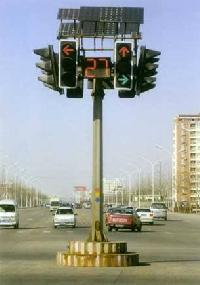
Solar Traffic Light
Solar traffic lights are signalling devices powered by solar panels positioned at road intersections, pedestrian crossings and other locations to control the flows of traffic. They assign the right of way to road users by the use of lights in standard colors (red - amberyellow - green), using a universal color code
...more
SOLAR SYSTEMS
Solar power is the conversion of energy from sunlight into electricity, either directly using photovoltaics (pv), or indirectly using concentrated solar power. Concentrated solar power systems use lenses or mirrors and tracking systems to focus a large area of sunlight into a small beam. Photovoltaic cells convert light into an electric current using the photovoltaic effect.
...more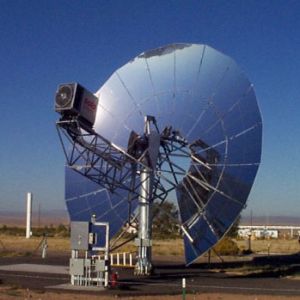
Solar Stirling Engine
A solar powered Stirling engine is a heat engine powered by a temperature gradient generated by the sun. It was patented by Roelf J. Meijer in 1987.[1] His invention relates a heat engine, such as a Stirling cycle engine, with a solar dish collector in order to produce electricity.[1] This apparatus consists of a large dish aimed at the sun to reflect the rays into the focus point, which is located at the center of the dish. Solar energy is then collected in the form of heat to fuel a Stirling cycle engine, [1] which operates by letting heat flow from a hot source to a cold sink in order to do work.[2] The work output of the Stirling cycle is then used to drive a generator and create electric power. Moreover, in Meijer’s solar-powered engine, it is important that the dish always be pointed directly at the sun so that no shadows would be present in the solar dish collector, hence optimizing heat collection. This is where he ran into some issues because, in order for the apparatus to have a complete range of motion, lubrication and rotational systems would be necessary and may compromise structural stability.
...more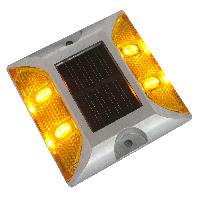
Solar Road Stud
Solar road studs are flashing solar cell powered LED maintenance-free lighting devices used in road construction to delineate road edges and centrelines. Embedded in the road surface, they are an electronic improvement on the traditional cat's eyes in that they may give drivers more than a thirty-second reaction window compared with about 3 seconds for conventional reflective devices. The intense brightness of the LEDs makes them easily visible at distances of about 900 m under favourable conditions.
...more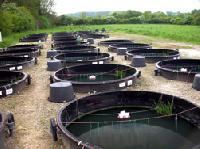
Solar pond
A solar pond is simply a pool of saltwater which collects and stores solar thermal energy. The saltwater naturally forms a vertical salinity gradient also known as a "halocline", in which low-salinity water floats on top of high-salinity water. The layers of salt solutions increase in concentration (and therefore density) with depth. Below a certain depth, the solution has a uniformly high salt concentration.
...more
Solar Inverter
A solar inverter, or converter or PV inverter, converts the variable direct current (DC) output of a photovoltaic (PV) solar panel into a utility frequency alternating current (AC) that can be fed into a commercial electrical grid or used by a local, off-grid electrical network. It is a critical balance of system (BOS)–component in a photovoltaic system, allowing the use of ordinary AC-powered equipment. Solar power inverters have special functions adapted for use with photovoltaic arrays, including maximum power point tracking and anti-islanding protection.
...more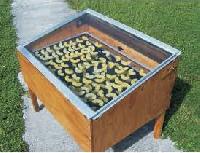
Solar Dryer
Traditional methods of food drying is to spread the foodstuffs to place the foodstuffs in the sun in the open air. This method, called sun drying, is effective for small amounts of food. The area needed for sun drying expands with food quantity and since the food is placed in the open air, it is easily contaminated. Therefore, one major reason why sun drying is not easily performed with larger quantities of food is that the monitoring and overview becomes increasingly more difficult with increasing food quantities.
...more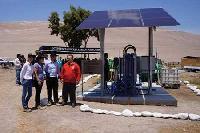
Solar Desalination Plant
Solar desalination is a technique to remove salts from water – usually seawater – using solar energy to make the water potable. Desalination has become important in supplying the world’s drinking water; In the middle of the 20th century, there were about 4,000 cubic meters of fresh water per person per year. Now, globally, we’re down to 1,000 cubic meters per person per year — a level that is defined as water scarcity. Some communities were using solar stills for desalination back in the 1950s, mostly in remote desert and coastal areas, but they didn’t really take off because of cheap pumps and pipelines and low energy costs. There are two major types of solar desalination systems: reverse osmosis and solar humidificationdehumidification. Reverse osmosis is a pressure-driven process that forces the separation of fresh water from other constituents through a semipermeable membrane; it is the method most used in large-scale desalination systems where electricity is readily available. The solar humidification-dehumidification (HDH) process, or multiple-effect humidification (MEH), is a technique that mimics the natural water cycle in a shorter time frame by evaporating and condensing water to separate it from other substances. The driving force in this process is thermal solar energy to produce water vapor that is later condensed in a separate chamber. Some HDH systems, collect the waste heat from the condensing water vapor and pre-heat the incoming water source; it’s often effective for small- to mid- scale desalination systems in remote locations because of the relatively low cost of solar collectors.
...more
Solar Cooker
A solar cooker is a device which uses the energy of direct sunlight to heat, cook or pasteurise drink. Many solar cookers currently in use are relatively inexpensive, low-tech devices, although some are as powerful or as expensive as traditional stoves,[1] and advanced, large-scale solar cookers can cook for hundreds of people.[2] because they use no fuel and cost nothing to operate, many nonprofit organizations are promoting their use worldwide in order to help reduce fuel costs (especially where monetary reciprocity is low) and air pollution, and to slow down the deforestation and desertification caused by gathering firewood for cooking. Solar cooking is a form of outdoor cooking and is often used in situations where minimal fuel consumption is important, or the danger of accidental fires is high, and the health and environmental consequences of alternatives are severe.
...more
Solar Air Conditioners
Solar air conditioning refers to any air conditioning (cooling) system that uses solar power. This can be done through passive solar, solar thermal energy conversion and photovoltaic conversion (sunlight to electricity). The U.S. Energy Independence and Security Act of 2007[1] created 2008 through 2012 funding for a new solar air conditioning research and development program, which should develop and demonstrate multiple new technology innovations and mass production economies of scale. Solar air conditioning might play an increasing role in zero-energy and energy-plus buildings design.
...more
SOLAR SYSTEMS

Solar Pump

Solar Electric Panels

Import car programmers
Be first to Rate
Rate This